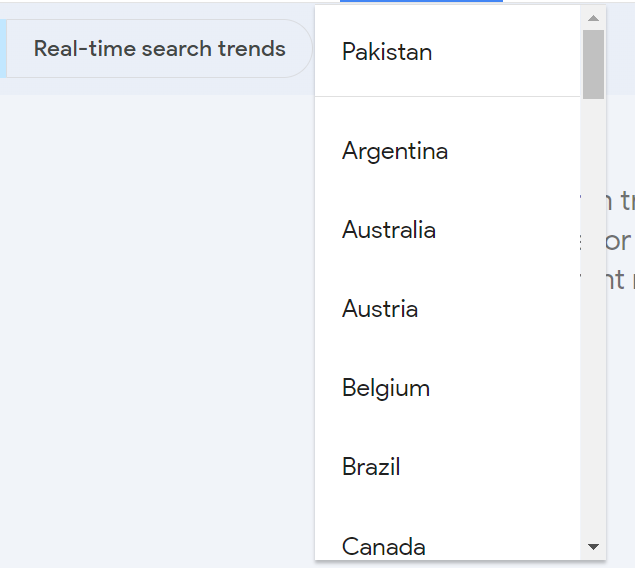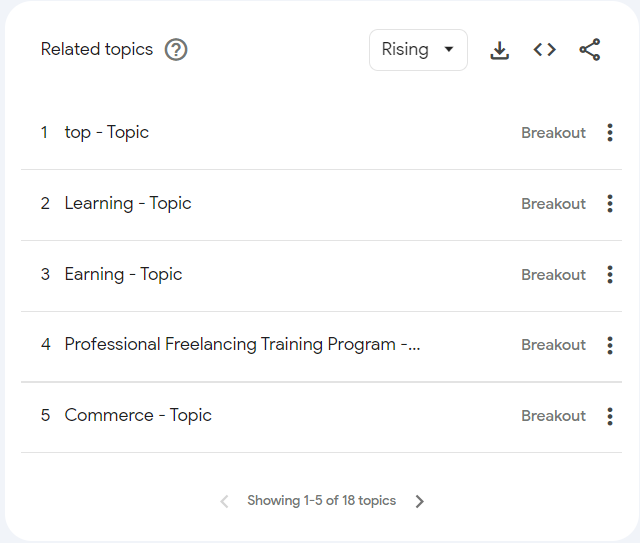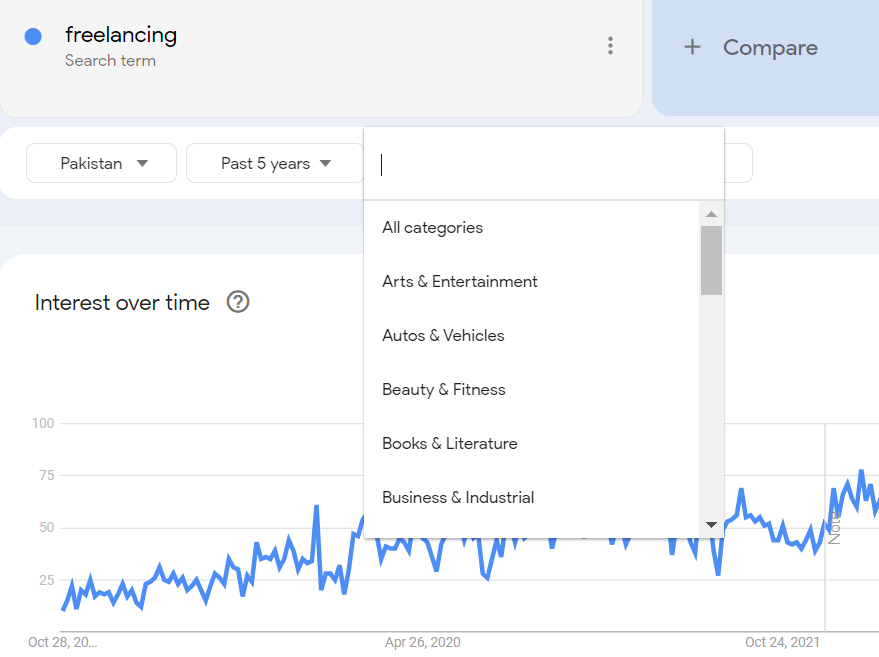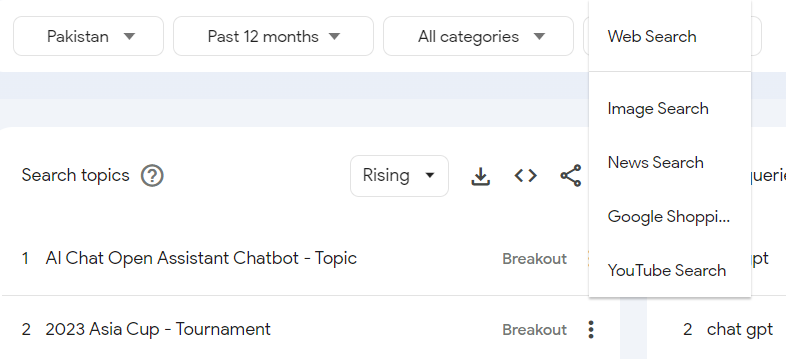One of Google’s tools, Google Trends, is a great source of information that can help improve SEO and content production. With real-time search trends, related inquiries, and category data available, Google Trends gives marketers a wealth of options to hone their approaches and maximise results.
This article is a thorough and comprehensive reference to Google Trends that covers all the necessary information to use it effectively for SEO and content marketing purposes.
You will gain an understanding of what Google Trends is, how it distinguishes itself from other keyword tools, and the various methodologies at your disposal to maximize its potential. By applying the insights from this guide, you can propel your website’s traffic and stay ahead in the competitive landscape.
You may also like: Content Marketing 2023: The Winning Approach
Let’s delve into it.
What Is Google Trends?
Google Trends serves as a search query analysis tool, displaying search trends graphically over a specified time frame.
It provides the functionality to compare up to five keyword search terms. It allows fine-tuning of results by adjusting parameters such as geographic location, topic, period, and search category (image, news, shopping, and video).
The keyword data can be tailored in four distinct ways:
- Geographic location (by individual country or globally).
- Topic categories (with 25 varieties available or all types simultaneously).
- Different search surfaces (image, news, shopping, YouTube).
- Time.
Time-Based Data
Keyword search trends can be broken down into eight distinct time intervals for analysis:
- The past hour.
- Past four hours.
- Past day.
- Past seven days.
- Past 30 days.
- Past 90 days.
- Past five years.
- 2004 – present.
How Does Google Trends Data Differ From Keyword Search Volumes?
Google Trends distinguishes itself from third-party keyword research tools through its unique approach. Unlike third-party tools, Google Trends doesn’t provide specific keyword search volume data. Instead, it presents search queries as percentages on a scale ranging from 0 to 100.
You may also like: 5 Best SEO Keyword Clustering Tools to Boost Your Rankings
Third-party SEO tools
While third-party SEO tools do offer keyword volume estimations, these are essentially educated guesses. These tools typically acquire data from external sources and then generate statistical approximations based on that data. These data sources are often software companies that aggregate anonymous search data from their users.
In contrast, Google Trends derives its data from a sample of actual search queries on Google, making it the most precise source of keyword search data available. Google Trends employs sampling methods because the actual volume of search data reaches into the billions, making it impractical to process all of it directly.
Google explains:
“While only a sample of Google searches are used in Google Trends, this is sufficient because we handle billions of searches per day.
Providing access to the entire data set would be too large to process quickly.
By sampling data, we can look at a dataset representative of all Google searches, while finding insights that can be processed within minutes of an event happening in the real world.”
Even though Google Trends doesn’t give exact numbers for keyword volumes, it does something similar. It shows keyword data as a percentage, with 100% meaning the most search traffic for a specific time.
How Can I Discover Trending Topics on Google Trends?
You can find trending searches on Google Trends utilizing two techniques: the “trending now” site page and the Google Trends Explore tool.
Trending Now The “trending now” section displays the top twenty daily search trends for the present day.
- You can click on a navigation button to view real-time search trends:

- Afterward, you can choose the relevant country:

- Then, pick the suitable category:

- You can select from the following available categories:
- Business.
- Entertainment.
- Health.
- Sci/Tech.
- Sports.
- Top Stories.
“Trending now” displays the current top trending keywords, and the selection of these keywords is made by the Google Trends algorithm.
How To Use Google Trends For SEO & Content Marketing
You can employ different methods to adjust the filters and obtain useful search query information.
Google Trends can also help you uncover new keyword phrases to focus on.
1. Utilize Google Trends Search Operators
- Google Trends responds to search operators, which alter the displayed data.
There are four search operators:
a. Quotation marks: ” “
- Usage: “keyword1 keyword2”
- This displays keyword data for an exact match of the keywords in the same order enclosed within the quotation marks. In the example, it shows data exclusively for “keyword1 keyword2.”
b. Plus sign: +
- Usage: keyword1 + keyword2
- This reveals keyword data for search phrases containing either one of the specified keywords.
c. Minus sign: –
- Usage: keyword1 – keyword2
- This showcases searches for keyword phrases that include the given keyword but exclude words containing the keyword indicated with the minus sign.
d. No Search Operators
- Usage: keyword1 keyword2
- Using no search operators shows search interest in keyword phrases that contain the given keywords in any order.
You may also like: How to Make Money With SEO: A Step-by-Step Guide for Beginners
2. Gain Insights from Time-Based Trends
- There are two primary ways to analyze keyword data: examining it over extended periods and investigating search interest in shorter timeframes.
Long-Term Trends
You can configure Google Trends to display traffic trends dating back to 2004. This is useful for understanding audience trends.
- Upward long-term trends: If a trend consistently shows an upward trajectory, it’s a signal to prioritize creating content around that trend.
- Downward long-term trends: When the trend line steadily declines, it may suggest changes in audience content consumption.
- Regular spikes: Spikes in searches occurring at consistent intervals could indicate seasonal patterns in search queries.
For example, review this five-year trend for Freelancing.
There is an upword trend for freelancing. So, you can easily find out trends of different keyword from google trends.
You may also like: Freelancing On A Platform Vs. Independent: Which One Is Best For You.
3. Related Topics And Queries
Google Trends offers two valuable features: “related topics” and “related queries.”
Topics
“Related topics” appear when you’re exploring a single keyword phrase; they don’t appear when you compare multiple keyword phrases.
These related topics are search queries that revolve around a familiar concept. Discovering associated issues that are on the rise can be insightful in understanding shifts in audience preferences or consumer demand.
This information can inspire content creation ideas or guide decisions on new product offerings.
Related Queries
Similar to related topics, related queries operate on the same principle.
Top queries typically represent the most widely searched terms, while rising queries indicate searches that are gaining popularity.
Data from rising queries can be precious for keeping a competitive edge.
4. Short-Term Trends Can Drive Significant Traffic
Examining keyword trends in the short term, like the 90-day or 30-day perspective, can offer valuable insights for leveraging swiftly changing search trends.
Significant traffic can be found in both Google Discover and Google News.
Google Discover showcases websites relevant to user interests, often featuring recently published content as well as evergreen material.
Google News focuses on current events and is always up-to-the-minute.
Websites targeting either of these traffic sources benefit significantly from understanding short-term trends. An advantage of studying short-term trends (over 30 and 90 days) is that certain days of the week emerge as peak periods for popular searches.
Understanding which days of the week experience increased interest in a particular topic can be valuable for scheduling when to release specific types of content. This way, your content will be readily available when the audience is actively searching for it.
5. Keywords By Category
Google Trends offers the capability to filter keyword search queries by category topics, enhancing the precision of keyword data. The Categories tab plays a crucial role as it fine-tunes your keyword research to the relevant context.
For instance, if your keyword context revolves around automobiles, it’s logical to customize Google Trends to display data exclusively within the automotive context. In this case, you can choose the category that aligns with your topic, such as Shopping or Autos and vehicles.
By narrowing down Google Trends data by category, you gain access to more accurate information pertaining to the subjects you’re investigating for content within the appropriate context.
6. Identify Keyword Data By Geography
Google Trends provides geographic-specific keyword data that can be leveraged for identifying prime areas for site promotion and tailoring content to specific regions.
For instance, if certain products gain popularity in places like Pakistan and India, it’s strategic to direct promotional efforts and create localized content for those regions. In fact, focusing initial link-building promotion in these high-interest areas can be quite advantageous.
Keyword popularity insights by region hold significance for various aspects, including link building, content creation, content promotion, and pay-per-click campaigns.
Localizing and promoting content can enhance its relevance to individuals interested in that content or product. Google ranks pages based on relevance, so incorporating geographic context into your content can improve its visibility to a broader audience.
You may also like: Why Keyword Research and Planning is important for SEO?
7. Target Search Intents With Search Types
Google Trends provides the option to fine-tune keyword data by categorizing it according to the source of the search – known as the search type.
Segmenting your Google Trends analysis by search type enables you to eliminate any distracting factors that could be clouding your keyword research, resulting in more precise and meaningful insights.
Google Trends data can be sorted by:
- Google Shopping.
- Image search.
- News search.
- Web search.
- YouTube search.
YouTube search is an excellent method for pinpointing search trends related to content featuring the term “how” because numerous users on YouTube tend to search using phrases that include “how.”
Even though these searches occur on YouTube, the trends data is valuable as it reveals what users are seeking.
Harness the Potential of Google Trends for SEO
Google Trends provides a wealth of insights into how users conduct searches, which can be highly beneficial for SEO and content strategy.
While there may be a slight learning curve, mastering it is manageable. Give Google Trends a try to delve into how your target audiences are searching.









